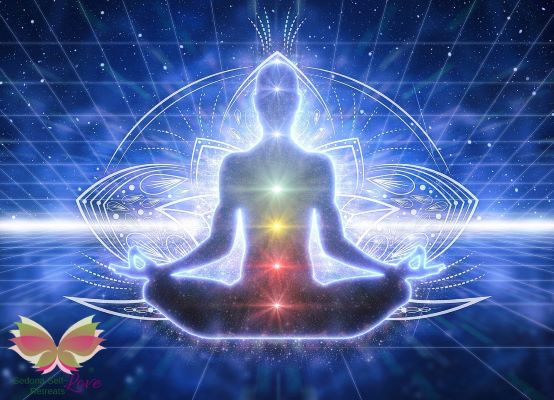
“Yoga is more than physical. It is cellular, mental, intellectual and spiritual – it involves man in his entire being.” ~ B.K.S. Iyengar
I recently read an article that began with this quote and was inspired to expand upon the idea in regards to the value of including a yoga practice in any self-discovery journey or healing program. At various times in our lives we come to a crossroads where our choices and decisions have great impact on our future trajectory. We can all agree that change is the only constant, but the circumstances and external stimulation of modern life can make navigating our way confusing and overwhelming. Sometimes we can anticipate this change, other times we are broadsided by what is transpiring and it takes courage to seek help. When energy swirls like that, it is intuitive to want to pause, regroup, and get centered-which are basic yogic themes. These are also major themes of a Sedona Self-Love Retreat.
Highly seasoned and experienced practitioners are at the heart of Sedona Self-Love Retreats providing a variety of therapeutic modalities to support a change to a person’s situation and what they are experiencing. Each retreat is individualized, but the gains are the same: new coping tools, new approaches, increased positivity, deeper connections, a renewed sense of self through the power of love. Again, major themes of a yoga practice.
The inspiration and courage that brings one to a retreat is rooted in some kind of desire for betterment, on a personal level, in relationships, self-exploration, or just getting away for a reset to rejuvenate in nature. Change prompts this desire and whatever the itinerary, yoga offers an approach for better health and wellness that will compliment and enrich any version of a Self-Love Retreat. Numerous scientific studies support the benefits of practicing yoga on a mental, cellular, intellectual and spiritual level. During times of big change, we can think of it as a form of movement, or even realignment. At the core of a yoga practice is aligning with our true Self, our structural body, and our perspectives and thoughts, which begins with the breath.
Most retreats cater to people going through life changes that are often challenging and difficult, and they are looking for support and new tools for coping with what is happening in their lives. Various methods, healing modalities, and new insights are quite nourishing during any life transition and yoga can assist in a person’s receptivity to change. The most important aspect of a yoga practice is the breath which is constantly moving in and out of your body and expanding and contracting your lungs and ribcage; like your breath is moving you. Steady slow rhythmic breath is scientifically proven to affect the parasympathetic nervous system imparting a sense of peace and calm which goes hand in hand with rational thought and mental clarity. Yoga can nurture this ideal state to be in when confronting life’s challenges while trying to apply new ideas and practices.
Mental Brain Boost
A new study has connected physical strength with improved cognitive function as we age. When engaging in challenging resistance exercises the body responds by releasing powerful chemicals: insulin-like growth factor 1 (IGF-1), brain-derived neurotrophic factor (BDNF), and irisin which are like brain fuel. These substances have a profound impact on your brain, promote the growth of new brain cells, support the survival of existing neurons, and enhance the brain’s ability to adapt and learn. Incorporating high-intensity strength training into your routine, not only builds a stronger physique but also enhances your cognitive abilities. The increased production of IGF-1 helps your brain create fresh neural connections, while BDNF ensures the longevity of your existing neurons. Improved memory, heightened focus, and enhanced mental resilience are the results. Yoga has a no pain, self-regulating approach to a variety of poses that stretch the muscles for more flexibility along with weight bearing and standing flow poses that provide the intensity to build strength and endurance.
Cellular Detox and Power Up Your Immunity
A recent connection between movement and well-being is the effect of stretching the fascia in the body and stimulating the lymphatic system. You can think of the lymphatic system as the garbage disposal of the body scavenging free radicals and debris and clearing it out of the system. Seventy percent of our lymphatic system is beneath the surface of the skin and simple stretching stimulates lymphatic flow where it is dumped into the collar bone lymph ducts for removal. Simple stretching also helps to smooth out the fascia that tends to get bunched up around tight spots and areas of tension. You can think of the fascia as a big knit sweater inside the body. Literally, fascia is made up of sheets of connective tissue that are dense with nerve endings found below the skin. These tissues attach, stabilize, impart strength, maintain vessel openness, separate muscles, and enclose different organs. All the nerve endings create a super highway of sensory communication in the body. Recently, the definition has been broadened to include all collagenous-based soft tissues in the body. Fascia is classified as superficial, deep, visceral, or parietal and further classified according to anatomical location. So, you get the idea of this knitted sweater throughout the inside of the body as densely innervated, layers of membrane with loosely packed interwoven collagen and elastic fibers. Superficial and deep fascia form a connection network that weaves in between fat lobules in the deep adipose tissue layer and the deep fascia has well developed lymphatic channels.
Peace and Calm Ease Chronic Pain and Anxiety
Fascia was thought to be passive structurally, but is now known to be very active. Not only does fascia provide support for surrounding tissues and organs, it helps to reduce friction and can transmit mechanical tension (a type of force that tries to stretch a material) generated by muscular activity or external forces. Movement affects and stimulates fascia and because it contains more nerve endings than any other tissue it is incredibly sensitive to change which gives it the potential to communicate change throughout the body. When fascial layers tighten and restrict the movement of underlying tissues the effect is pain, hindered range of motion, or decreased blood flow. In addition to cleansing the body of toxins, movement imparts ease in the body and wards of tension and pain which soothes the mind into peace and calm – an ideal state to be in when facing life changes and decisions.
Not only does physically moving the body create profound affects to ward off pain, but the movement of the breath, specifically deep diaphragmatic breathing or Dirga (or Deerga) Swasam Pranayama. Also known as Dirga, breathing deeply will increase your oxygen supply, which in turn, will help to decrease stress and anxiety levels. Dirga is also a simple and effective way to tone the Vagus nerve, the 10th cranial nerve. Good Vagal tone has been equated with good health and the “reset button” for equanimity in the body. Of course, it is not just the Vagus nerve being affected, but notably the dorsal vagal complex, as it is known, sends information to the regulatory regions of the brain which makes it an effective target for mind-body therapies.
Alignment Leads to Rational Thought and Connection to All Things
In Mind-Body Medicine there are Top-Down and Bottom-Up Mechanisms that contribute to mental and physical health through a reciprocal circuit of communication. Simplified, these terms respectively mean the brain sends messages down to the body, and the body sends messages up to the brain. This communication works along the neuroaxis where mind-body interactions occur. Bi-directional pathways transmit information between the central nervous system (CNS) and the periphery to facilitate autonomic, hormonal, and immune responses. The healthy functioning of these pathways are noted by heart rate variability and inflammation markers, conditions which are directly affected by mind-body therapies, like yoga, which affect both mechanisms through meditation, breathing, and physical exercises.
These neural pathways are referred to as somatic and autonomic (sympathetic and parasympathetic) and are part of the nervous system. Peripheral nerves associated with these systems are the conduit to Mind-body interactions. There is a reciprocal communication along these neural pathways, specifically vagal pathways that support transmission of psycho-physiological information from peripheral visceral tissue/organs to the brainstem, upward and back down, that provides the stimuli by which the mind/brain influences the body to respond to ongoing situations or challenges. The function of this reciprocal circuit of communication of ascending feedback to the executive centers of the brain enables these areas to integrate a range of physiological responses with mental activities which facilitates complex associative processes such as perception, behavioral intention, and planning. Therefore, optimal health depends upon efficient exchange of information between the periphery and the CNS, and is closely associated with the impulses coming from vagal tone and the fascia.
Definition of the mind according to Damasio, “With regard to mind-body medicine, we define the mind as conscious and unconscious thought patterns, including images, perceptions, and intentions, generated by a functional network of distributed neural centers in the brain and body, including homeostatic representations that provide the context for human self-awareness and emotional experience.”
Clearly, movement is an intrinsic part of affecting the mind. Through movement we activate and strengthen our body’s powerful communication systems. Optimal functioning of these systems can lead to a sense of wholeness that creates a direct connection with Source, or cosmic consciousness and your innate knowing. This creates expansion beyond the self and the “union” that defines yoga. Union with Source, union with other people, union with the planet that we live on and beyond. The potential of this expansiveness becomes so great that new possibilities are revealed, and in that sense movement can become the portal to any transition and betterment in life.
In Sanskrit, the word Yoga means to join, to yoke, or to unite. According to yogic scriptures the practice leads to the union of individual consciousness with that of universal consciousness, indicating a perfect harmony between the mind and body, Man and Nature. – Dr. Ishwar V. Basavaraddi
~ Marnie Mills, Sedona Self-Love Retreats Practitioner
Mantra: Language of Sound
Learn yogic practices to raise your vibration, such as Kundalini mantra meditations.
Moving into Alignment with Yoga
Improve body, mind, and spirit... overall wellness through yoga and meditation practice.
Universe Laws and Free Will
Explore spiritual laws of the universe during your private Sedona Self-Love Spiritual Retreat. Gain wisdom to take with you through this life and beyond.
Self-Love Optimum Nutrition
Support your Self-Love Retreat by rethinking your optimum nutrition.



